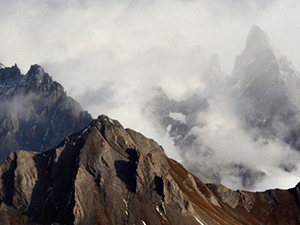MOUNTAIN AGRICULTURE
PATHWAY 1
MOUNTAIN AGRICULTURE
PATHWAY 1
Promotion of Alpine products and increase in locally retained added value for a sustainable and climate-friendly agriculture

Basic information:
Alpine farming products have special characteristics of naturalness and high quality. Often they derive from Alpine species and are produced through traditional or locally adapted methods. Local production and consumption allow for a reduction of CO2 emissions, and regional tourism in the Alps especially outside winter has seen an increase in local or regional green or climate-neutral offers and packages.
Alpine agricultural products enter value chains extending sometimes far beyond the Alpine region. If on the one hand this provides a significant economic trigger to local products, on the other hand this could be responsible for emissions from transport for food miles. At the same time, tourist diversification represents a major phenomenon to be observed across the Alps and visitors appreciate tasting local products on site, live a comprehensive tourist experience and bring back some of them to their places of origin. Alpine farming products show an inner high natural quality, tend to organise as niche productions, and need to see their full value (and costs) recognised in the consumer price. The resulting pathway tends to incorporate different trends and address both climate & socioeconomic dimensions in the agricultural sector in the Alps including support to regional agriculture, local consumption of mountain products, direct marketing (shortening of the value chain), simplified access to mountains, promotional activities including a “climate message”, climate and value added indicators applied at the level of farms.
Sequence of implementation steps:
Identification of proper indicators for climate-friendly and sustainable farming to be applied at the farm level (organisation) or at the farming product level (good): indicators have to include mitigation and adaptation dimensions (e.g., use of renewable energy, GHG emissions, water use, use of chemicals, use of locally produced animal feed, etc.) as well as economic and social sustainability metrics (e.g., added value, serviced people, canteens, restaurants, shops, etc.). Indicators can be collected and harmonised from existing experiences within and outside the Alpine region. The resulting system of indicators should deliver a complete information on the GHG impact of products from Alpine agriculture that can be used as a basis for private and public decision-making.
Step 2: Set-up of an Alpine regional strategy for climate-friendly agricultural products (2021-2025)
- Technical specific support and divulgation of better techniques and marketing strategies focalised for the Alpine farmers
- Marketing initiatives for commercialising Alpine products locally in restaurants, hotels, shops, catering etc.
- Green public procurement applied by local administrations within the region (e.g., school and public offices canteens, etc.)
- Incentivisation of direct marketing/commercialisation of Alpine farming products from farmers aimed to shorten the value chain and increase the share of added value retained by the producer
Note that a proper consideration of the dimension of the “region” where the commercialisation of Alpine farming products should be promoted is needed.
An “EU Day” dedicated to mountain/Alpine products with major events and supported by an EU-wide campaign should be determined and launched with a widespread support from Alpine countries and the Alpine Convention/PSAC.
On this day, special voluntary public & private initiatives for promoting the consumption and knowledge of Alpine products and their attached benefits (including climate-friendliness, ecosystem services, biodiversity, cultural aspects, etc.) should be held in major cities in the Alps.
Commercial initiatives by farmers, restaurants, agritourist facilities etc. could be concentrated in the period around the EU Day (e.g., Alpine cuisine menus in restaurants, tasting events, courses, a multi-media campaign etc.)
Further Information:
- Academics or Consultants in the field of sustainability indicators, EU Commission DG Agriculture, DG Climate, DG Environment, Alpine Convention – ACB, PSAC and Contracting Parties, national and regional administrations involved in farming & food policies, tourism development, environmental policies, representatives/ stakeholders of tourism and mountain destinations or centres, companies and entrepreneurs in fields linked to food value-chains, farmers’ associations
- NGOs involved in promoting sustainable tourism (CIPRA, ALPARC etc.)
- Local consumption of Alpine agricultural products in Alpine regions
Promotion of local Alpine products as natural, tasty and climate-friendly - Increase in value added & income from marketing of climate-friendly local products for Alpine farmers
- Evaluation/report on CO2 impacts of a higher use of Alpine products and local value chains
- Step 1: Quantitative and qualitative and description of achieved results (indicator system and farmers joining the scheme)
- Step 2: Number of initiatives, destinations/towns, products involved and qualitative descriptions where needed
- Step 3: Qualitative description of the organisational aspects of the day; number of stakeholders agreeing to participate with own initiatives, description of outreach of the activities
- Green Economy Action Plan of the Alpine Convention (2019)
- RSA4 “Sustainable Tourism in the Alps – Report on the State of the Alps” (2013)
- Report of the WG Sustainable Tourism (2016)
- PSAC (2017). ALPINE SIGNALS 8 – Alpine Convention Mountain
- Agriculture Platform
- Local initiatives in Alpine countries (e.g., Project: Adopt an Alpine Organic Valley, Italy)
- Bergsteigerdörfer (stock taking No. 61) which have one focus on promotion and use of local and regional products
- Initiative “So schmecken die Berge“ (taste of the mountains) of the German and Austrian Alpine Clubs (stock taking No. 64)
- Interreg Alpine Space Project AlpFoodway

